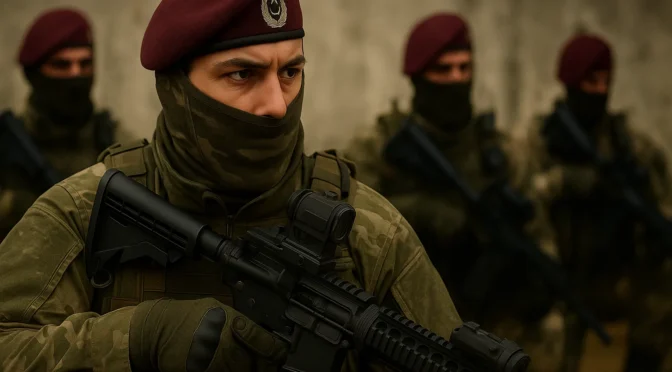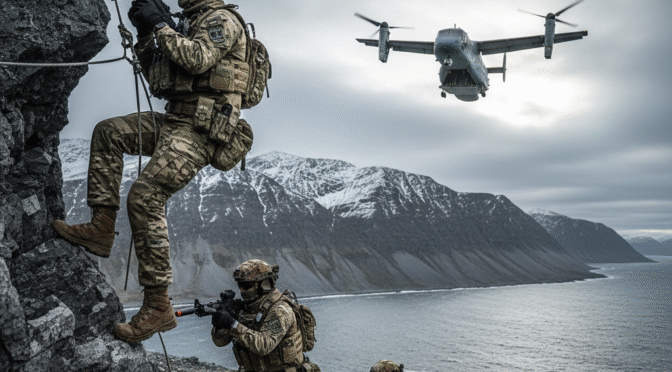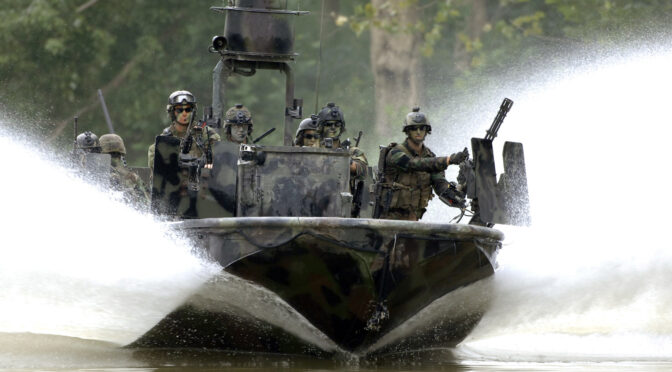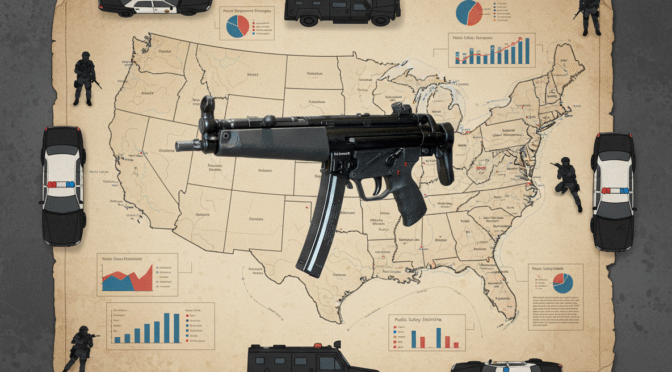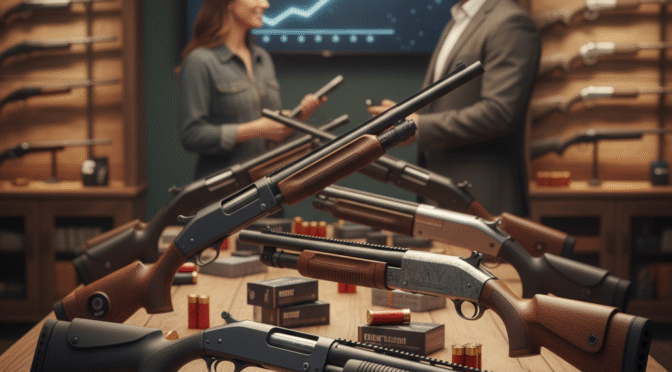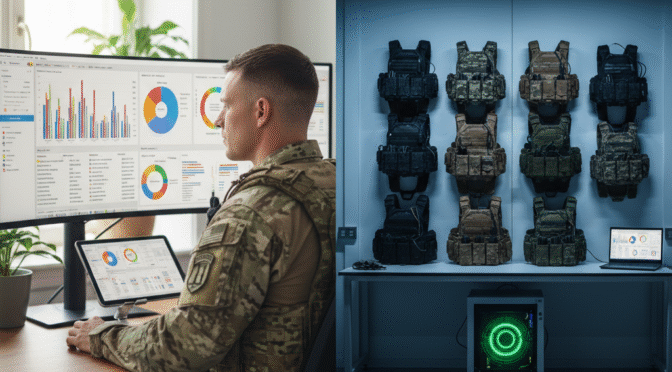The Turkish Special Forces Command (Özel Kuvvetler Komutanlığı – ÖKK), known colloquially as the “Maroon Berets” (Bordo Bereliler), represents the apex of the Turkish Armed Forces’ (TAF) operational capabilities and a primary instrument of Turkish strategic power projection. This report provides a comprehensive analysis of the ÖKK’s evolution, from its clandestine Cold War origins to its current status as a battle-hardened, technologically advanced special operations force (SOF). The analysis demonstrates that the ÖKK’s development has been forged through decades of relentless conflict, most notably the counter-insurgency campaign against the Kurdistan Workers’ Party (PKK) and extensive expeditionary operations in Syria and Northern Iraq.
The unit’s genesis lies in a NATO “stay-behind” organization established in 1952, a foundation that instilled a unique and enduring culture of unconventional warfare, operational autonomy, and strategic thinking. This Cold War DNA proved uniquely suited to the asymmetric challenges that would define its future. Formally established as the ÖKK in 1992 to counter the escalating PKK insurgency, the Maroon Berets honed their skills in the mountainous terrain of Southeast Turkey and Northern Iraq, mastering long-range reconnaissance, intelligence-driven targeting, and high-value target capture, exemplified by the strategic capture of PKK founder Abdullah Öcalan in 1999.
The post-2015 era marked the most profound transformation in the unit’s history. The shift of the PKK conflict into dense urban environments forced a brutal but necessary evolution in tactics, from rural counter-insurgency to high-intensity urban warfare. The lessons learned were immediately applied in large-scale cross-border interventions in Syria, where the ÖKK evolved from a direct-action unit into the vanguard of complex, combined-arms operations, effectively employing the “by, with, and through” model with Syrian proxy forces. This period was also defined by a technological revolution, with the integration of indigenous armed drones and network-centric warfare capabilities fundamentally altering the ÖKK’s operational paradigm.
This evolution is mirrored in the unit’s arsenal. The ÖKK has pursued a sophisticated dual-track procurement strategy, equipping its operators with best-in-class Western systems like the Heckler & Koch HK416A5 rifle while simultaneously driving the development of and integrating advanced indigenous platforms from Turkish firms such as Sarsılmaz and Kale Kalıp. This approach ensures immediate Tier-1 capability while mitigating geopolitical risks and fostering national industrial independence.
Looking forward, the ÖKK is poised to expand its role beyond counter-terrorism into the broader spectrum of strategic competition, acting as the tip of the spear for Turkey’s “forward defense” doctrine. Its future will be characterized by deeper integration of artificial intelligence, autonomous systems, and man-unmanned teaming. However, the most critical variable in its long-term trajectory may be the human dimension, as the impact of post-2016 institutional reforms on the TAF’s officer corps will ultimately shape the culture and leadership of this elite force. The ÖKK’s journey from a clandestine cell to a strategic SOF is a direct reflection of Turkey’s own rise as a formidable regional military power, and it stands today as one of the world’s most experienced and capable special operations forces.
Section 1: Genesis and Cold War Origins (1952-1992)
The foundational identity of the Turkish Special Forces Command cannot be understood without first examining its origins within the clandestine architecture of the Cold War. Forged as an instrument of unconventional warfare in the face of a potential Soviet invasion, its early mandate, doctrine, and training established a unique culture of autonomy, deep infiltration, and strategic patience. This “Cold War DNA” would prove to be the critical enabler of its successful transformation decades later into a premier counter-insurgency and expeditionary force. Its initial purpose was not to conduct raids, but to organize and lead a national resistance from the shadows, a mission that required a fundamentally different mindset and skill set than conventional military operations.
1.1 The NATO Imperative: Formation of the Tactical Mobilization Group (STK)
The geopolitical landscape following the Second World War positioned Turkey as a critical frontline state against the Soviet Union. Its accession to the North Atlantic Treaty Organization (NATO) in 1952 was a strategic necessity, cementing its place within the Western security alliance.1 This new alignment, however, came with specific and often secret obligations. The primary threat was a large-scale Warsaw Pact invasion, a scenario for which conventional defense might not be sufficient. In this context, NATO strategists developed a “stay-behind” concept to ensure continued resistance even after a country was overrun.
On September 27, 1952, Turkey established the “Special and Auxiliary Combat Units” (Hususi ve Yardımcı Muharip Birlikleri), an organization that would soon be known as the Tactical Mobilization Group (Seferberlik Taktik Kurulu – STK).2 This unit was an integral part of NATO’s “Operation Gladio,” a continent-wide network of clandestine anti-communist organizations designed to form the nucleus of a resistance movement in the event of a Soviet occupation.4 The founding goal, as outlined in charters like that of the U.S. Office of Policy Coordination (OPC), was unambiguous: to conduct “propaganda, economic warfare; preventative direct action, including sabotage, anti-sabotage, demolition… [and] subversion against hostile states, including assistance to underground resistance movements, guerrillas and refugee liberations groups”.4 This mandate for unconventional warfare (UW), focused on organizing, training, and leading guerrilla forces, became the bedrock of the unit’s identity and its core doctrinal purpose for the next four decades.
1.2 Doctrine and Development: The Special Warfare Department (ÖHD)
The institutionalization of this special warfare capability continued to evolve. On December 14, 1970, the STK was formally reorganized and renamed the Special Warfare Department (Özel Harp Dairesi – ÖHD), placing it directly under the command of the Turkish General Staff.2 This change signified a more permanent and integrated role for special warfare within Turkey’s national defense posture.
The doctrinal and training lineage of the ÖHD was heavily influenced by the United States from its inception. The core of the unit was formed by a cadre of sixteen Turkish soldiers, including its founder Daniş Karabelen, who had been sent to the United States in 1948 for specialized training in special warfare.4 This early partnership established a direct link to the doctrine and methods of U.S. Army Special Forces, a relationship that would continue for decades, as evidenced by later U.S. military studies examining the application of American SOF assessment and selection models to their Turkish counterparts.10 The training provided by the U.S. was comprehensive, covering sabotage, subversion, and guerrilla leadership, with financial support provided under the Truman Doctrine.4
The operational doctrine of the ÖHD was fundamentally different from that of a direct-action or commando unit. Its primary mission was strategic and long-term. Operatives, mostly reserve officers, were recruited, inducted with an oath, and educated in clandestine methods. After their training, they were not formed into standing units but were returned to their civilian lives, forming a latent, cellular network of sleeper agents to be activated only in the event of an invasion.4 This methodology fostered a culture of extreme discretion, operational security, and the ability to work in small, autonomous teams without support or communication for extended periods.
Despite its primary “stay-behind” mission, the unit was not entirely dormant. Its operators were deployed to engage in counter-guerrilla operations on the Korean Peninsula during the Korean War.2 In November 1953, under the name Mobilized Reconnaissance Board, its personnel were sent to Cyprus. There, they undertook long-range reconnaissance and, critically, were tasked with arming and organizing the Turkish Resistance Organization (TMT) to counter the Greek Cypriot EOKA group.2 This early mission was a classic example of foreign internal defense and unconventional warfare, demonstrating a nascent capability to operate abroad to organize, train, and advise a partner force—a core SOF competency that would become central to its missions in the 21st century. The ÖHD’s activities in Cyprus, which included clandestine arms transfers and false flag operations to foster resistance, were a direct application of its special warfare training, proving its operational value long before it was formally re-roled to combat the PKK.8
The ÖHD’s foundational mission as a “stay-behind” force instilled a deep-seated culture of unconventional warfare, strategic thinking, and operational autonomy that distinguishes it from special forces units created purely for counter-terrorism or direct action. This legacy provided a ready-made skill set that proved directly applicable to the complex counter-insurgency challenges that would later define its primary role. The very nature of the Gladio program required operators who were not simply elite soldiers, but also intelligence operatives, political organizers, and trainers capable of building a resistance movement from scratch. This mission necessitated long-term planning, political acumen, and the ability to operate in completely denied areas without support, all of which are core UW competencies. When the primary threat to Turkish sovereignty shifted from a conventional Soviet invasion to a deeply entrenched domestic insurgency, these exact skills—operating in hostile territory, clandestine intelligence gathering, and working with local populations (in this case, the Village Guard system)—were precisely what was required. This inherent adaptability, born from its unique Cold War origins, explains the unit’s rapid and effective transition to the counter-PKK role after its 1992 reorganization.
Section 2: Forged in Conflict: The Counter-PKK Insurgency (1992-2015)
The collapse of the Soviet Union and the end of the Cold War rendered the ÖHD’s primary “stay-behind” mission obsolete. Simultaneously, a new and more immediate threat had reached a critical level: the insurgency waged by the Kurdistan Workers’ Party (PKK). In response, the Turkish high command undertook a strategic pivot, transforming its clandestine special warfare apparatus into a proactive and kinetic special operations force. The establishment of the Özel Kuvvetler Komutanlığı in 1992 marked the beginning of a new era. For nearly a quarter of a century, the ÖKK was forged in the crucible of relentless counter-insurgency warfare, an experience that shaped its doctrine, tested its limits, and ultimately established its reputation as one of the world’s most seasoned and effective special operations units.
2.1 Establishment of the ÖKK: A Strategic Pivot
The formal creation of the Special Forces Command on April 14, 1992, was a direct and calculated response to a dramatically altered security environment.2 The 1991 Gulf War had created a power vacuum in Northern Iraq, which the PKK exploited to establish a secure safe haven beyond the reach of conventional Turkish forces. The ongoing insurgency in Turkey’s southeast, which had begun in 1984, had proven to be a complex challenge that conventional military tactics struggled to contain.2 The Turkish General Staff recognized that this asymmetric threat required a specialized response.
The ÖHD was consequently restructured, expanded, and renamed the ÖKK, transitioning from a department to a brigade-level command.2 This reorganization was more than a name change; it represented a fundamental shift in mandate and operational tempo. The unit’s mission evolved from a latent anti-Soviet contingency role to an active, front-line counter-terrorism and unconventional warfare mandate, operating directly under the authority of the Turkish General Staff.2 Its designated task was to conduct special operations that “exceed the capabilities of other military units,” a clear acknowledgment of the unique demands of the counter-PKK fight.2 This decision marked the formal transition of Turkey’s special warfare capability from a strategic reserve held for a hypothetical war to a primary operational tool deployed in an active and ongoing conflict. It was a strategic admission by the military leadership that the PKK insurgency was not a conventional problem and required a specialized, unconventional solution.
2.2 The Asymmetric Battlefield: TTPs and Landmark Operations
Deployed immediately into the conflict, the ÖKK honed its tactics, techniques, and procedures (TTPs) in the rugged, mountainous terrain of Southeast Turkey and across the border in Northern Iraq. This environment became their primary training ground and operational theater. The unit specialized in deep reconnaissance, direct action raids on PKK training camps, and intelligence-driven operations to disrupt the insurgency’s command and logistics networks.2
The ÖKK quickly distinguished itself through its exceptional capability in high-value targeting (HVT) operations, which had strategic, rather than merely tactical, impacts on the conflict. In 1998, in a complex operation involving intelligence penetration and cooperation with Iraqi Kurdish Peshmerga forces, an ÖKK team captured senior PKK commander Şemdin Sakık in Dohuk, Northern Iraq.2 This was followed by their most significant achievement: the 1999 capture of PKK founder and leader Abdullah Öcalan. After an international manhunt, Öcalan was tracked to Nairobi, Kenya, where he was apprehended by an ÖKK team, reportedly with intelligence and technological assistance from international partners, and flown back to Turkey.2
These HVT captures were not just tactical victories; they were strategic psychological operations that demonstrated the long reach of the Turkish state and its intelligence dominance. The removal of the insurgency’s founder and a key military commander severely disrupted the PKK’s command structure, damaged its morale, and created internal divisions. These successes showcased the ÖKK’s ability to conduct operations with strategic, political-level effects, a hallmark of a Tier 1 special operations force.
The unit’s consistent success on the battlefield led to its formal expansion. In 2006, the ÖKK was upgraded from a brigade to a division-level command, with its leadership elevated from Major General to Lieutenant General. This expansion included the formation of new brigades and a planned doubling of its personnel from roughly 7,000 to 14,000 operators by 2009.2 The elite status of the Maroon Berets was cemented on the international stage in 2004, when they competed against twenty-six other elite units and ranked first at the World Special Forces Championship held in Germany.2
2.3 Armament of the Era: The Heckler & Koch Legacy
The small arms utilized by the ÖKK during the 1990s and into the early 2000s reflected the broader arsenal of the Turkish Land Forces, which was heavily influenced by German designs produced under license by the state-owned Mechanical and Chemical Industry Corporation (MKEK).
The primary individual weapon for ÖKK operators was the G3A7, a Turkish variant of the Heckler & Koch G3 battle rifle.21 Chambered in the powerful 7.62x51mm NATO cartridge, the G3 was a robust and reliable weapon well-suited to the long-range engagements common in the mountainous terrain of the conflict zone. Alongside the G3, the MKEK-produced HK33E, chambered in 5.56x45mm NATO, was also issued, offering a lighter platform with a higher magazine capacity for greater firepower in closer engagements.21
For suppressive fire, the standard squad automatic weapon was the MKEK-produced MG3, a modernized version of the German MG 42 machine gun, also chambered in 7.62x51mm NATO.22 In situations requiring a more compact weapon, such as vehicle operations or close-quarters battle (CQB), operators were equipped with variants of the Heckler & Koch MP5 submachine gun.21
While this inventory of weapons was dependable and effective, it was largely identical to that issued to conventional Turkish commando brigades. The rifles lacked the modularity of Picatinny rail systems, which were becoming standard for Western SOF units, limiting the easy attachment of advanced optics, lasers, and other accessories. This reliance on standard-issue infantry weapons, albeit of high quality, represented a technological and tactical gap when compared to their international counterparts. This gap would be comprehensively addressed in the subsequent decade as the nature of the ÖKK’s missions became even more complex and specialized.
Section 3: The Modern Battlefield: Syria, Urban Combat, and Proactive Defense (2015-Present)
The period from 2015 to the present marks the most profound and rapid transformation in the history of the Turkish Special Forces Command. The collapse of a two-and-a-half-year ceasefire with the PKK plunged the ÖKK into a new and brutal form of warfare: high-intensity urban combat within Turkish cities. The hard-won, costly lessons from this experience were immediately put to the test in a series of large-scale expeditionary operations in Syria. In this new theater, the ÖKK evolved from a counter-insurgency force into the vanguard of Turkey’s combined-arms military, mastering the art of advising and leading proxy forces while integrating revolutionary new technologies. This era cemented the Maroon Berets’ role as the primary tool for Turkey’s “forward defense” doctrine, projecting power far beyond its borders to shape regional security outcomes.
3.1 A New Kind of War: The Urban Conflict (2015-2016)
Following the breakdown of the ceasefire in July 2015, the nature of the conflict with the PKK underwent a dramatic shift.18 Instead of confining their operations to the rural, mountainous countryside, PKK-affiliated urban youth militias, known as the Civil Protection Units (YPS), moved the fight into the densely populated centers of cities in Southeast Turkey, such as Cizre, Sur (in Diyarbakır), and Nusaybin.25 These groups transformed neighborhoods into urban fortresses, employing tactics that included digging trenches, erecting barricades, and extensively using improvised explosive devices (IEDs) to channel security forces into kill zones. This strategy was augmented by the deployment of seasoned PKK snipers, who inflicted significant casualties on advancing troops.27
This new operational environment rendered many of the ÖKK’s traditional rural counter-insurgency skills obsolete and demanded a rapid and brutal adaptation. Long-range patrolling and mountain warfare tactics were replaced by the methodical, high-risk requirements of urban combat. Operators had to master Close Quarters Combat (CQC) and advanced building-clearing techniques, including the use of explosive breaching to overcome fortified positions.12 Crucially, they had to learn to integrate their operations seamlessly with conventional heavy assets, such as main battle tanks and artillery, which were brought in to reduce fortified structures.26 This period of intense urban warfare was the ÖKK’s “Fallujah moment”—a costly and bloody learning experience that forged the unit’s modern urban doctrine and created a deep reservoir of practical experience that would provide a distinct advantage in its subsequent operations in Syria.
3.2 The Syrian Interventions: From Advisors to Vanguards
The expertise gained in the cities of Southeast Turkey was almost immediately applied across the border. Beginning in 2016, Turkey launched a series of major military interventions into Northern Syria, with the ÖKK serving as the tip of the spear.
Operation Euphrates Shield (2016-2017): This was Turkey’s first major ground intervention in Syria, aimed at clearing the Islamic State (ISIS) from its border and preventing the Syrian-Kurdish YPG (which Turkey views as a PKK affiliate) from linking its territories.29 In the initial phases, ÖKK teams operated alongside Turkish armored units and elements of the Free Syrian Army (FSA), providing targeting expertise and direct-action capabilities. The protracted and difficult battle for the city of Al-Bab against a determined ISIS defense served as a critical post-graduate course in urban warfare. The heavy Turkish casualties sustained there highlighted initial challenges in effectively integrating SOF, conventional armor, and proxy infantry, providing invaluable lessons for future campaigns.32
Operation Olive Branch (2018): Applying the lessons from Al-Bab, this operation targeted the YPG-controlled enclave of Afrin. The campaign demonstrated a more refined operational model. It began with a massive and sustained air and artillery bombardment, utilizing 72 combat aircraft in the opening hours to systematically degrade YPG defenses, command posts, and subterranean tunnel networks.32 This was followed by a multi-pronged ground offensive led by ÖKK operators and Turkish commandos, who guided thousands of allied Syrian National Army (SNA) fighters through the mountainous approaches and into Afrin’s urban center.30
In these Syrian campaigns, the ÖKK fully matured into its role as a force multiplier. It executed the classic SOF “by, with, and through” doctrine, where a relatively small number of elite operators advise, assist, and accompany a much larger partner force. The ÖKK provided the critical command and control, intelligence fusion, precision fire support coordination, and elite strike capabilities that enabled the SNA to function as an effective ground-holding force.29 These interventions marked the ÖKK’s definitive graduation from a domestic and cross-border counter-terrorism unit to a true expeditionary special operations force, capable of planning and executing complex combined-arms operations as a primary instrument of Turkish foreign policy.
3.3 The Technology Revolution: Drones and Networked Warfare
The operational evolution of the ÖKK during this period was inextricably linked to a technological revolution within the Turkish military, most notably the widespread deployment of indigenously produced unmanned aerial vehicles (UAVs). The Bayraktar TB2 armed drone proved to be a genuine “game changer” in the fight against both the PKK and other adversaries.37 These platforms provided ÖKK teams on the ground with persistent, real-time intelligence, surveillance, and reconnaissance (ISR), allowing them to track enemy movements and identify targets with unprecedented clarity. More importantly, the TB2’s ability to deploy precision-guided munitions gave ground teams an immediate and highly accurate strike capability, enabling the targeting of high-level PKK cadres in previously inaccessible mountain hideouts and command posts in Northern Iraq.15
The culmination of this technological and doctrinal integration was showcased during Operation Spring Shield in Idlib, Syria, in early 2020. In response to a deadly airstrike on Turkish troops, the TAF launched a devastating counter-attack against Syrian Arab Army positions. This operation demonstrated a new level of sophistication in modern warfare. Turkish forces, with ÖKK elements likely providing forward observation and targeting, seamlessly combined the effects of armed drones, long-range artillery, and the KORAL electronic warfare system. This network-centric approach allowed them to systematically locate, jam, and destroy Syrian air defense systems, tanks, and artillery pieces with overwhelming speed and precision.29 It was a clear demonstration that the Turkish Armed Forces, with the ÖKK at the forefront of integrating new technologies, had mastered a mature form of multi-domain, networked warfare.
Section 4: The Current Arsenal of the ÖKK: A Detailed Small Arms Analysis
The contemporary small arms inventory of the Özel Kuvvetler Komutanlığı is a direct reflection of its operational evolution and its status as a Tier 1 special operations force. The arsenal is characterized by a sophisticated, multi-layered procurement strategy that prioritizes operator-level specialization, modularity, and a dual-track approach of acquiring best-in-class foreign systems while simultaneously fostering and integrating advanced domestically produced platforms. This strategy ensures immediate interoperability with NATO partners and access to the world’s most advanced weaponry, while also building Turkey’s defense industrial base and mitigating the geopolitical risks of arms embargoes. The result is a diverse and highly capable arsenal tailored to the full spectrum of special operations, from clandestine reconnaissance to high-intensity direct action.
4.1 Sidearms: Precision and Reliability
The sidearm is a critical secondary weapon for any special operator, valued for its reliability in close-quarters engagements and as a backup system. The ÖKK employs a range of high-quality pistols from both foreign and domestic manufacturers.
- Glock 17 & 19: The Austrian-made Glock 17 (full-size) and Glock 19 (compact) pistols, chambered in 9x19mm Parabellum, are considered standard-issue sidearms for the ÖKK.2 Their worldwide adoption by military and law enforcement units is a testament to their exceptional reliability, simple design, and high-capacity magazines. The polymer frame makes them lightweight, and the vast aftermarket support allows for extensive customization to fit operator preference.40
- Heckler & Koch USP: The German Heckler & Koch Universal Self-loading Pistol (USP) in.45 ACP is also in the ÖKK inventory.2 The choice of the larger.45 ACP caliber suggests a preference for greater stopping power in certain tactical scenarios. The USP is renowned for its durability and its proprietary recoil reduction system, which mitigates the recoil of the powerful cartridge.41
- SIG Sauer P226 & P229: The Swiss/German SIG Sauer P226 and its more compact variant, the P229, are elite pistols used by numerous premier special operations forces globally, including the U.S. Navy SEALs.2 Chambered in calibers such as.40 S&W, these hammer-fired pistols are praised for their exceptional accuracy and ergonomics.43
- Sarsılmaz SAR9 SP: Demonstrating the growing capability of Turkey’s domestic defense industry, the ÖKK has adopted the SAR9 SP, a specialized variant of the striker-fired SAR9 pistol produced by the Turkish firm Sarsılmaz.44 Developed specifically to meet the requirements of the Special Forces Command, its inclusion in the inventory signifies that domestic designs have achieved the high standards of reliability and performance demanded by elite units.44
4.2 Primary Carbines: The Elite Standard
The primary weapon of the ÖKK operator is the carbine, which must be accurate, reliable, and modular to adapt to diverse mission requirements. The ÖKK has largely moved away from the older generation of MKEK-produced rifles to adopt platforms that are the standard for top-tier international SOF.
- Heckler & Koch HK416A5: The German HK416A5 is the principal assault rifle of the Maroon Berets.22 Chambered in 5.56x45mm NATO, it utilizes a short-stroke gas piston system derived from the H&K G36 rifle. This system prevents combustion gases from entering the receiver, which significantly increases reliability and reduces fouling compared to traditional direct impingement systems.48 The A5 variant features fully ambidextrous controls, a tool-less adjustable gas regulator for use with suppressors, and a high degree of modularity via its Picatinny rail system.49 Its adoption places the ÖKK’s primary weapon on par with units like U.S. Delta Force and the Norwegian Special Forces.
- Colt M4A1: The American-made Colt M4A1 carbine, also in 5.56x45mm NATO, remains in use, particularly with Turkish Naval SOF units like the Su Altı Taarruz (SAT).2 The M4A1 is the baseline for modern military carbines, known for its light weight, compact size, and extensive combat record.51
- Sarsılmaz SAR 56: In a significant development, the ÖKK has begun procuring the Turkish-made Sarsılmaz SAR 56 assault rifle to supplement and potentially eventually replace its HK416s.46 The SAR 56 is an AR-15 platform rifle that operates with a short-stroke gas piston system, similar to the HK416. It is available in multiple barrel lengths (7.5″, 11″, and 14.5″) to suit different roles, from CQB to standard infantry use.45 Its acquisition by the ÖKK indicates that the domestic rifle has successfully passed the rigorous testing and met the demanding standards required for special operations use.
- Kale Kalıp KCR556: Another advanced domestic platform, the KCR556 from Kale Kalıp, is in limited use with Turkish Commando and Gendarmerie SOF units and has been combat-proven in operations like Olive Branch.21 Like the SAR 56, it is a short-stroke gas piston rifle based on the AR-15 architecture, available in various barrel lengths and featuring a high degree of modularity.53
4.3 Battle Rifles & Designated Marksman Rifles (DMRs)
For engagements requiring greater range and barrier penetration than 5.56x45mm ammunition can provide, ÖKK squads employ a variety of 7.62x51mm NATO weapon systems.
- FN SCAR-H: The Belgian FN SCAR-H is a modern battle rifle used by the ÖKK.21 It is highly valued for its powerful 7.62x51mm cartridge, modular design allowing for quick barrel changes, and excellent ergonomics, including a folding stock and fully ambidextrous controls.
- MKE MPT-76 / KNT-76: The MKE MPT-76 is Turkey’s national infantry rifle, designed to replace the G3.55 It is a short-stroke gas piston rifle heavily influenced by the HK417 design.55 The ÖKK employs the dedicated marksman rifle variant, the KNT-76. The KNT-76 features a longer, 20-inch barrel and a refined trigger, which improves its effective range to 800 meters and its accuracy to a consistent 1.5 Minutes of Angle (MOA), making it a capable semi-automatic precision platform.55
- KAC M110 SASS: The American Knight’s Armament Company M110 Semi-Automatic Sniper System (SASS) is a key DMR in the ÖKK’s inventory.2 Based on the AR-10 platform, the M110 is renowned for its exceptional accuracy and allows the designated marksman to deliver rapid, precise follow-up shots at extended ranges.
4.4 Sniper Systems: Strategic Precision
Long-range precision fire is a critical SOF capability, used for reconnaissance, overwatch, and the elimination of high-value or strategic targets. The ÖKK employs a diverse and world-class inventory of bolt-action sniper rifles for both anti-personnel and anti-materiel roles.
Anti-Personnel Systems:
- Sako TRG Series: The Finnish Sako TRG-22 (chambered in.308 Winchester/7.62x51mm) and the TRG-42 (chambered in the powerful.338 Lapua Magnum) are highly respected precision rifles used by the ÖKK.2 They are known for their “out-of-the-box” sub-MOA accuracy, fully adjustable stocks, and crisp two-stage triggers.56
- Accuracy International AWM/AXMC: The British Accuracy International Arctic Warfare Magnum (AWM) and its successor, the AX Multi Caliber (AXMC), are legendary in the sniper community for their ruggedness and extreme accuracy.2 Chambered in.338 Lapua Magnum, these rifles provide the ability to engage targets well beyond 1,500 meters.61 The AXMC features a quick-change barrel system, allowing operators to switch calibers (e.g., to.300 Win Mag or.308 Win) in the field.61
Anti-Materiel Systems:
- Barrett M82A1 & McMillan Tac-50: For engaging hard targets such as light vehicles, radar equipment, and enemy ordnance at extreme ranges, the ÖKK utilizes American-made.50 BMG (12.7x99mm NATO) rifles. These include the semi-automatic Barrett M82A1 and the bolt-action McMillan Tac-50, both of which are capable of effective fire out to 2,000 meters and beyond.2
- Kale Kalıp KSR50: Complementing the foreign systems is the Turkish Kale Kalıp KSR50, a bolt-action.50 BMG sniper rifle.64 The adoption of the KSR50 by the ÖKK demonstrates that Turkey’s domestic industry can now produce high-caliber precision rifles that meet the stringent requirements of its most elite unit.64
4.5 Support & Specialized Weapons
To round out their capabilities, ÖKK teams are equipped with a range of specialized weapons for suppressive fire and close-quarters engagements.
- Light Machine Guns (LMG): The primary squad support weapon is the Belgian FN Minimi, chambered in 5.56x45mm NATO.22 This belt-fed LMG provides a high volume of mobile, suppressive fire, essential for fire and maneuver tactics.66 Turkey’s Kale Kalıp has also developed the KMG556, a domestic LMG based on the Minimi design, which is being introduced into service.67
- Submachine Guns (SMG) & Personal Defense Weapons (PDW): While largely supplanted by short-barreled carbines like the 11-inch HK416A5, traditional SMGs still have a niche. The H&K MP5 series (9x19mm) remains in the inventory for specific CQB or low-visibility missions where over-penetration is a concern.2 For defeating body armor in a compact platform, the ÖKK uses the H&K MP7A1 PDW, which fires a proprietary high-velocity 4.6x30mm round.2
4.6 Table: Current Small Arms of the Turkish Special Forces Command (ÖKK)
The following table summarizes the primary small arms currently in service with the ÖKK, reflecting the unit’s dual-track procurement strategy of utilizing both elite international and advanced domestic weapon systems.
| Weapon Type | Model | Caliber | Country of Origin | Role/Notes |
| Sidearm | Glock 17 / 19 | 9×19mm | Austria | Standard issue sidearm. |
| Heckler & Koch USP | .45 ACP | Germany | Specialized sidearm, valued for stopping power. | |
| SIG Sauer P226 / P229 | .40 S&W / 9×19mm | Switzerland/Germany | Elite sidearm, noted for accuracy. | |
| Sarsılmaz SAR9 SP | 9×19mm | Turkey | Domestically developed pistol for ÖKK. | |
| Assault Rifle / Carbine | Heckler & Koch HK416A5 | 5.56×45mm | Germany | Primary issue carbine; Tier-1 SOF standard. |
| Sarsılmaz SAR 56 | 5.56×45mm | Turkey | Domestically produced rifle supplementing the HK416. | |
| Colt M4A1 | 5.56×45mm | USA | Standard NATO carbine, used by various units. | |
| Kale Kalıp KCR556 | 5.56×45mm | Turkey | Domestically produced rifle in limited use. | |
| Battle Rifle | FN SCAR-H | 7.62×51mm | Belgium | Modular battle rifle for increased firepower. |
| Designated Marksman Rifle | MKE KNT-76 | 7.62×51mm | Turkey | Standard issue domestic DMR. |
| KAC M110 SASS | 7.62×51mm | USA | High-precision semi-automatic sniper system. | |
| Sniper Rifle (Anti-Personnel) | Sako TRG-22 | .308 Win | Finland | Bolt-action precision rifle. |
| Sako TRG-42 | .338 Lapua Magnum | Finland | Long-range bolt-action precision rifle. | |
| Accuracy Int’l AWM/AXMC | .338 Lapua Magnum | UK | Premier long-range anti-personnel system. | |
| Sniper Rifle (Anti-Materiel) | Barrett M82A1 | .50 BMG | USA | Semi-automatic anti-materiel rifle. |
| McMillan Tac-50 | .50 BMG | USA | Bolt-action anti-materiel rifle. | |
| Kale Kalıp KSR50 | .50 BMG | Turkey | Domestically produced anti-materiel rifle. | |
| Light Machine Gun | FN Minimi | 5.56×45mm | Belgium | Standard issue squad automatic weapon. |
| Kale Kalıp KMG556 | 5.56×45mm | Turkey | Domestically produced LMG. | |
| Submachine Gun / PDW | Heckler & Koch MP5 Series | 9×19mm | Germany | Used for specialized CQB roles. |
| Heckler & Koch MP7A1 | 4.6×30mm | Germany | Personal Defense Weapon for defeating body armor. |
Section 5: The Future of the Maroon Berets: A Speculative Outlook to 2035
Projecting the future of an elite special operations force like the ÖKK requires an analysis that synthesizes global trends in warfare, Turkey’s specific strategic ambitions, and the internal dynamics of its military-industrial complex and institutional structures. While counter-terrorism will undoubtedly remain a core competency, the ÖKK’s trajectory over the next decade will likely be defined by its expanding role in great power competition, its deep integration with autonomous systems and artificial intelligence, and the long-term effects of profound institutional reforms within the Turkish Armed Forces. The Maroon Berets of 2035 will be shaped as much by algorithms and geopolitics as by the battlefield experiences that have defined their past.
5.1 Evolving Geopolitical Roles: From COIN to Great Power Competition
The operational focus of U.S. and NATO special operations forces is shifting from the counter-terrorism-centric missions of the post-9/11 era toward the challenges of strategic competition with peer and near-peer adversaries.69 The ÖKK’s future missions will likely mirror this global trend. While the threat from the PKK or successor groups will necessitate a persistent counter-terrorism capability, the force will increasingly be leveraged as a tool of Turkish foreign policy in wider geopolitical arenas. This will involve an expansion of its irregular warfare, foreign internal defense (FID), and security force assistance (SFA) missions to build partnerships and project influence in regions of strategic importance to Turkey, such as Africa, the Caucasus, and Central Asia.
This evolution aligns perfectly with Turkey’s established “forward defense” doctrine, a strategic posture that seeks to confront and neutralize threats far beyond its borders before they can directly impact national security.71 The successful application of this doctrine in Syria and Northern Iraq, where the ÖKK was the central enabling force, has validated the concept. In the future, ÖKK teams will likely be deployed to train, advise, and potentially lead partner forces in these new theaters, creating strategic depth for Turkey and countering the influence of rival powers with a light, cost-effective, and politically discreet footprint.
5.2 Doctrinal and Technological Integration
The future battlefield will be dominated by information, with victory depending on the ability to collect, process, and act on data faster and more effectively than the adversary.74 The future ÖKK operator will evolve from being primarily a kinetic actor to a manager of information and a commander of autonomous systems. They will function as critical human nodes within a vast, AI-enabled battle network, leveraging advanced C4ISR (Command, Control, Communications, Computers, Intelligence, Surveillance, and Reconnaissance) systems to achieve information dominance and orchestrate effects across multiple domains.75
This will manifest in the widespread adoption of man-unmanned teaming (MUM-T). The ÖKK’s proven ability to effectively integrate armed drones like the Bayraktar TB2 into its ground operations is a precursor to this future.37 The next evolution in TTPs will see ÖKK teams moving beyond simply calling in airstrikes to directly controlling a suite of unmanned assets. This could include loyal wingman UCAVs like the Bayraktar Kızılelma, autonomous ground robotics for reconnaissance and breaching, and intelligent drone swarms for overwhelming enemy defenses.74 The operator’s primary value will shift from their skill with a carbine to their ability to command this network of robotic assets to achieve strategic objectives with a minimal physical signature.
5.3 The Human Dimension: The Impact of Institutional Reform
While technology will reshape the battlefield, the single most critical component of any special operations force is the quality of its personnel. In this regard, the most significant and uncertain variable for the ÖKK’s long-term future lies in the profound institutional reforms undertaken within the Turkish military following the 2016 coup attempt. The closure of the historic military academies and the centralization of all officer and NCO training under the newly established National Defense University (Milli Savunma Üniversitesi – MSÜ) represents a fundamental reshaping of the TAF’s leadership pipeline.78
As of 2025, a large percentage of the TAF officer corps are graduates of this new system, and within a few years, nearly every officer will have been educated under its curriculum.78 Since the ÖKK recruits its operators almost exclusively from the ranks of experienced officers and NCOs from the Land Forces, the character and quality of this recruitment pool will be determined by the MSÜ system.3 A critical question for the future is whether this new, centralized system—designed to ensure political loyalty to the government—will continue to foster the rigorous, meritocratic, and apolitical standards essential for producing the kind of highly intelligent, adaptable, and fiercely independent-minded leaders that define elite SOF units. Any degradation in the quality of officer candidates, or a cultural shift that prioritizes loyalty over battlefield merit, could, over a decade, alter the unique ethos that has made the Maroon Berets so effective.
5.4 Materiel Self-Sufficiency: The 2030 Vision
Turkey’s national “2030 Industry and Technology Strategy” explicitly aims for full independence and global leadership in critical technologies, with the defense sector being a primary focus.80 This national ambition will directly shape the ÖKK’s future arsenal. The current dual-track procurement strategy will likely transition to a “domestic-first” approach as Turkish industry matures.
By 2035, it is conceivable that the majority of the ÖKK’s equipment—from next-generation modular rifles and advanced optics to personal C4I systems, encrypted communications, and robotic platforms—will be of Turkish design and manufacture. The ÖKK will continue to serve as a key driver and end-user for this development, providing the Turkish defense industry with invaluable operational requirements and combat feedback to ensure that new indigenous systems are not just technologically advanced, but also practical, reliable, and battle-ready.76 This symbiotic relationship will accelerate innovation and ensure that the Maroon Berets are equipped with systems tailored specifically to their unique mission sets and Turkey’s strategic priorities.
Conclusion
The evolution of the Özel Kuvvetler Komutanlığı is a remarkable story of adaptation and transformation, mirroring the trajectory of the Turkish Republic itself in the 21st century. From its origins as a clandestine “stay-behind” unit created for a hypothetical Cold War conflict, the Maroon Berets have been forged into a premier special operations force through the unrelenting pressures of real-world combat. Their journey traces a clear and logical arc: a foundation in the principles of unconventional warfare provided the ideal skill set to confront the asymmetric challenge of the PKK insurgency. Decades of grueling counter-insurgency in the mountains of Anatolia and Iraq instilled a level of experience and resilience matched by few units worldwide.
This experience, in turn, became the bedrock for the unit’s most significant evolution. The brutal urban battles of 2015-2016 forced a doctrinal shift that prepared them for the complexities of modern hybrid warfare. In the subsequent expeditionary campaigns in Syria, the ÖKK demonstrated its maturity, leading large-scale combined-arms operations and mastering the integration of revolutionary drone technology. This progression transformed the unit from a national counter-terrorism asset into a vital instrument of regional power projection.
Today, the ÖKK’s diverse, world-class arsenal and its sophisticated, battle-tested doctrine place it firmly in the top tier of global special operations forces. Looking ahead, the force is poised to continue its evolution, embracing autonomous systems and expanding its role in strategic competition. As Turkey continues to chart an independent and assertive course in a volatile region, the Maroon Berets—embodying their motto, “The difficult we do immediately. The impossible takes a little longer“—will remain its sharpest and most indispensable strategic tool.
If you find this post useful, please share the link on Facebook, with your friends, etc. Your support is much appreciated and if you have any feedback, please email me at in**@*********ps.com. Please note that for links to other websites, we are only paid if there is an affiliate program such as Avantlink, Impact, Amazon and eBay and only if you purchase something. If you’d like to directly contribute towards our continued reporting, please visit our funding page.
Sources Used
- History – Kara Kuvvetleri Komutanlığı, accessed September 6, 2025, https://www.kkk.tsk.tr/en/kkksablonmaster/header/institutional/landforcescommand/history.aspx
- Special Forces Command (Turkey) – Wikipedia, accessed September 6, 2025, https://en.wikipedia.org/wiki/Special_Forces_Command_(Turkey)
- Special Forces Command (Turkey) – Wikiwand, accessed September 6, 2025, https://www.wikiwand.com/en/articles/Special_Forces_Command_(Turkey)
- Counter-Guerrilla – Wikipedia, accessed September 6, 2025, https://en.wikipedia.org/wiki/Counter-Guerrilla
- Özel Kuvvetler Komutanlığı – Wikiwand, accessed September 6, 2025, https://www.wikiwand.com/tr/articles/%C3%96zel_Kuvvetler_Komutanl%C4%B1%C4%9F%C4%B1
- tr.wikipedia.org, accessed September 6, 2025, https://tr.wikipedia.org/wiki/%C3%96zel_Harp_Dairesi#:~:text=%C4%B0lk%20olarak%201952%20y%C4%B1l%C4%B1nda%20%22Hususi,%C3%96zel%20Harp%20Dairesi%20ad%C4%B1n%C4%B1%20alm%C4%B1%C5%9Ft%C4%B1r.
- en.wikipedia.org, accessed September 6, 2025, https://en.wikipedia.org/wiki/Special_Forces_Command_(Turkey)#:~:text=On%2014%20December%201970%2C%20it,brigade%20transitioned%20to%20a%20division.
- Special Warfare Department – Wikipedia, accessed September 6, 2025, https://en.wikipedia.org/wiki/Special_Warfare_Department
- Özel Harp Dairesi – Vikipedi, accessed September 6, 2025, https://tr.wikipedia.org/wiki/%C3%96zel_Harp_Dairesi
- Assessment and Selection of Personnel for the Turkish Special Forces Command – DTIC, accessed September 6, 2025, https://apps.dtic.mil/sti/tr/pdf/ADA350142.pdf
- en.wikipedia.org, accessed September 6, 2025, https://en.wikipedia.org/wiki/Special_Forces_Command_(Turkey)#:~:text=The%20Special%20Forces%20Command%20(Turkish,under%20the%20Turkish%20General%20Staff.
- Özel Kuvvetler Komutanlığı – Vikipedi, accessed September 6, 2025, https://tr.wikipedia.org/wiki/%C3%96zel_Kuvvetler_Komutanl%C4%B1%C4%9F%C4%B1
- Assessment of the Turkish-Kurdish Conflict, 1984-1999 – Small Wars Journal, accessed September 6, 2025, https://smallwarsjournal.com/2024/06/19/assessment-turkish-kurdish-conflict-1984-1999/
- Türkiye – nato shape, accessed September 6, 2025, https://shape.nato.int/turkey
- Tackling the PKK: New Directions for Turkey’s Special Forces …, accessed September 6, 2025, https://jamestown.org/program/tackling-the-pkk-new-directions-for-turkeys-special-forces/
- About: Special Forces Command (Turkey) – DBpedia, accessed September 6, 2025, https://dbpedia.org/page/Special_Forces_Command_(Turkey)
- List of Turkish operations in northern Iraq – Wikipedia, accessed September 6, 2025, https://en.wikipedia.org/wiki/List_of_Turkish_operations_in_northern_Iraq
- Conflict Between Turkey and Armed Kurdish Groups | Global Conflict Tracker – Council on Foreign Relations, accessed September 6, 2025, https://www.cfr.org/global-conflict-tracker/conflict/conflict-between-turkey-and-armed-kurdish-groups
- “Bordo Bereliler”(Maroon Berets): Turkey’s Most Elite Military Special Forces Unit, accessed September 6, 2025, https://defencesecurityasia.com/en/bordo-berelilermaroon-berets-turkeys-most-elite-military-special-forces-unit/
- Kurdistan Workers’ Party insurgency – Wikipedia, accessed September 6, 2025, https://en.wikipedia.org/wiki/Kurdistan_Workers%27_Party_insurgency
- List of equipment of the Turkish Land Forces – Wikipedia, accessed September 6, 2025, https://en.wikipedia.org/wiki/List_of_equipment_of_the_Turkish_Land_Forces
- Turkish Armed Forces and Jandarma Weapons – Far East Tactical, accessed September 6, 2025, https://fareastmilsim.com/-page
- Heckler & Koch HK33 – Wikipedia, accessed September 6, 2025, https://en.wikipedia.org/wiki/Heckler_%26_Koch_HK33
- The HK33: A Legendary Battle Rifle From H&K – HKPARTS, accessed September 6, 2025, https://hkparts.net/blog/hk33-a-legendary-battle-rifle-from-heckler-koch/
- Türkiye’s PKK Conflict: A Visual Explainer | International Crisis Group, accessed September 6, 2025, https://www.crisisgroup.org/visual-explainers/turkiyes-pkk-conflict-visual-explainer
- Diyarbakir and the Turkish military offensive: The spoils of urban warfare | Qantara.de, accessed September 6, 2025, https://qantara.de/en/article/diyarbakir-and-turkish-military-offensive-spoils-urban-warfare
- The PKK’s Urban Warfare Tactics – Atlantic Council, accessed September 6, 2025, https://www.atlanticcouncil.org/blogs/menasource/the-pkk-s-urban-warfare-tactics/
- BORDO BERELİLER | ÖZEL KUVVETLER KOMUTANLIĞI KARARGAHI! – Asker TV | Askeri, Güvenlik ve Savunma Sanayii Sitesi, accessed September 6, 2025, https://www.askertv.com/bordo-bereliler-ozel-kuvvetler-komutanligi-karargahi.html
- Turkish involvement in the Syrian civil war – Wikipedia, accessed September 6, 2025, https://en.wikipedia.org/wiki/Turkish_involvement_in_the_Syrian_civil_war
- Turkey’s military operation in Syria and its impact on relations with …, accessed September 6, 2025, https://www.europarl.europa.eu/EPRS/EPRS-Briefing-642284-Turkeys-military-operation-Syria-FINAL.pdf
- Operation Euphrates Shield: Aims and Gains | Carnegie Endowment for International Peace, accessed September 6, 2025, https://carnegieendowment.org/posts/2017/01/operation-euphrates-shield-aims-and-gains?lang=en
- Operation Olive Branch: A Political Military Assessment | Carnegie Endowment for International Peace, accessed September 6, 2025, https://carnegieendowment.org/posts/2018/01/operation-olive-branch-a-political-military-assessment?lang=en
- Fighting ISIS in Syria: Operation Euphrates Shield and the lessons learned from the al-Bab Battle – IDEAS/RePEc, accessed September 6, 2025, https://ideas.repec.org/a/taf/fswixx/v33y2022i3p350-381.html
- Suriye’nin kuzeyindeki operasyonlarla 6 yılda yaklaşık 17 bin terörist etkisiz hale getirildi, accessed September 6, 2025, https://www.aa.com.tr/tr/gundem/suriyenin-kuzeyindeki-operasyonlarla-6-yilda-yaklasik-17-bin-terorist-etkisiz-hale-getirildi/2749677
- Operation Olive Branch: A Political – Military Assessment – Edam, accessed September 6, 2025, https://edam.org.tr/wp-content/uploads/2018/01/Operation-Olive-Branch-01.pdf
- Turkey ramps up military support for Syria – FDD’s Long War Journal, accessed September 6, 2025, https://www.longwarjournal.org/archives/2025/08/turkey-ramps-up-military-support-for-syria.php
- Turkey’s PKK Conflict: A Regional Battleground in Flux | International Crisis Group, accessed September 6, 2025, https://www.crisisgroup.org/europe-central-asia/western-europemediterranean/turkey/turkeys-pkk-conflict-regional-battleground-flux
- Irak’ın Kuzeyinde İcra Edilen “PENÇE-KİLİT OPERASYONU” Hakkında Açıklama MSB, accessed September 6, 2025, https://www.msb.gov.tr/SlaytHaber/1842022-23372
- Operation Spring Shield – Wikipedia, accessed September 6, 2025, https://en.wikipedia.org/wiki/Operation_Spring_Shield
- Why is the Glock 19 pistol the favorite of the world’s most elite forces? – Sandboxx, accessed September 6, 2025, https://www.sandboxx.us/news/why-is-the-glock-19-the-favorite-pistol-of-special-forces/
- Heckler & Koch USP – Wikipedia, accessed September 6, 2025, https://en.wikipedia.org/wiki/Heckler_%26_Koch_USP
- USP TACTICAL – HK USA, accessed September 6, 2025, https://hk-usa.com/product/usp-tactical/
- SIG Sauer P226 – Wikipedia, accessed September 6, 2025, https://en.wikipedia.org/wiki/SIG_Sauer_P226
- Turkish weapon SARSILMAZ becomes a police weapon in the US, accessed September 6, 2025, https://www.sarsilmaz.com/en/new_detail/turkish-weapon-sarsilmaz-becomes-a-police-weapon-in-the-us
- SARSILMAZ – Leading Brand of the Weapon Industry – Gun | Rifle …, accessed September 6, 2025, https://www.sarsilmaz.com/en
- Özel Kuvvetler Komutanlığına yerli saldırı tüfeği: SAR56 | DefenceTurk, accessed September 6, 2025, https://www.defenceturk.net/ozel-kuvvetler-komutanligina-yerli-saldiri-tufegi-sar56
- HK416A5 and HK USP using by Turkish SF ÖKK operators, and Turkish made infantary rifle MPT-76 [1079×1072] : r/MilitaryPorn – Reddit, accessed September 6, 2025, https://www.reddit.com/r/MilitaryPorn/comments/1aml7mh/hk416a5_and_hk_usp_using_by_turkish_sf_%C3%B6kk/
- Heckler & Koch HK416 – Wikipedia, accessed September 6, 2025, https://en.wikipedia.org/wiki/Heckler_%26_Koch_HK416
- HK416 – Heckler & Koch, accessed September 6, 2025, https://www.heckler-koch.com/en/Products/Military%20and%20Law%20Enforcement/Assault%20rifles/HK416
- M4A1 using by Turkish Navy SOF SAT operators [2252×4000] : r/MilitaryPorn – Reddit, accessed September 6, 2025, https://www.reddit.com/r/MilitaryPorn/comments/1afdyr9/m4a1_using_by_turkish_navy_sof_sat_operators/
- M4 carbine – Wikipedia, accessed September 6, 2025, https://en.wikipedia.org/wiki/M4_carbine
- Kale KCR – Wikipedia, accessed September 6, 2025, https://en.wikipedia.org/wiki/Kale_KCR
- KCR556 – KALE KALIP, accessed September 6, 2025, https://www.kalekalip.com.tr/products/kcr-556
- KCR556 7,5” PDW – KALE KALIP, accessed September 6, 2025, https://www.kalekalip.com.tr/products/kcr556/kcr556-7-5-pdw
- MKE MPT – Wikipedia, accessed September 6, 2025, https://en.wikipedia.org/wiki/MKE_MPT
- SAKO TRG-42 – Sniper Central, accessed September 6, 2025, https://snipercentral.com/sako-trg-42/
- Sako TRG 22/42, accessed September 6, 2025, https://www.sako.global/rifle/sako-trg-2242
- TECHNICAL SPECIFICATION SAKO TRG 22 / 42 – Outdoor Enterprise SA, accessed September 6, 2025, https://www.outdoor-enterprise.ch/TRG-42Techspecspdf-85adc300
- Sako TRG 22 A1 Bolt-Action Centerfire Rifle Review – RifleShooter, accessed September 6, 2025, https://www.rifleshootermag.com/editorial/sako-trg-22-a1-bolt-action-rifle-review/470943
- Accuracy International AWM – Wikipedia, accessed September 6, 2025, https://en.wikipedia.org/wiki/Accuracy_International_AWM
- ACCURACY AXMC SNIPER RIFLE – TR Equipement, accessed September 6, 2025, https://www.tr-equipement.com/en/our-products/armement/armes/28-accuracy-axmc-sniper-rifle.html
- Accuracy International Super Magnum – Sniper Central, accessed September 6, 2025, https://snipercentral.com/pm_sm.htm
- Barrett M82 – Wikipedia, accessed September 6, 2025, https://en.wikipedia.org/wiki/Barrett_M82
- Defence Turkey – KALE KALIP, accessed September 6, 2025, https://www.kalekalip.com.tr/newsroom/defence-turkey
- KSR50 – KALE KALIP, accessed September 6, 2025, https://www.kalekalip.com.tr/products/ksr50
- FN Minimi – Wikipedia, accessed September 6, 2025, https://en.wikipedia.org/wiki/FN_Minimi
- KALEKALIP MAK. VE KALIP SAN. A.Ş. – IDEF, accessed September 6, 2025, https://kalekalip-mak-ve-kalip-san-as.idef.com.tr/
- KMG556 – Turkish Minimis in Ukraine – The Armourers Bench, accessed September 6, 2025, https://armourersbench.com/2025/04/13/turkish-minimis-in-ukraine/
- The next decade of strategic competition: How the Pentagon can use special operations forces to better compete – Atlantic Council, accessed September 6, 2025, https://www.atlanticcouncil.org/in-depth-research-reports/report/the-next-decade-of-strategic-competition-how-the-pentagon-can-use-special-operations-forces-to-better-compete/
- Building Strategic Lethality: Special Operations Models for Joint Force Learning and Leader Development, accessed September 6, 2025, https://digitalcommons.ndu.edu/cgi/viewcontent.cgi?article=1306&context=joint-force-quarterly
- Turkey’s Military Operations in Syria and Iraq – Stiftung Wissenschaft …, accessed September 6, 2025, https://www.swp-berlin.org/10.18449/2022C37/
- Turkey’s Military Operations in Syria and Iraq – Stiftung Wissenschaft und Politik, accessed September 6, 2025, https://www.swp-berlin.org/publications/products/comments/2022C37_TurkeysOperations_Syria_Iraq.pdf
- A Shifting Centrality : The Evolution of Turkish Strategic Posture – ResearchGate, accessed September 6, 2025, https://www.researchgate.net/publication/374763286_A_Shifting_Centrality_The_Evolution_of_Turkish_Strategic_Posture
- The Future of the Battlefield – Office of the Director of National Intelligence – Global Trends, accessed September 6, 2025, https://www.dni.gov/index.php/gt2040-home/gt2040-deeper-looks/future-of-the-battlefield
- Battle Networks and the Future Force – CSIS, accessed September 6, 2025, https://www.csis.org/analysis/battle-networks-and-future-force-1
- The KAAN and beyond: Turkish defense firms highlight domestic capability, with eyes abroad, accessed September 6, 2025, https://breakingdefense.com/2025/09/the-kaan-and-beyond-turkish-defense-firms-highlight-domestic-capability-with-eyes-abroad/
- Senior Official Outlines Future Priorities for Special Ops – DoD, accessed September 6, 2025, https://www.defense.gov/News/News-Stories/Article/Article/4179258/senior-official-outlines-future-priorities-for-special-ops/
- 76 percent of Turkish army officers now graduates of Erdogan’s military schools – Nordic Monitor, accessed September 6, 2025, https://nordicmonitor.com/2025/09/two-thirds-of-turkish-army-now-graduates-of-erdogans-military-schools/
- Milli Savunma Üniversitesi, accessed September 6, 2025, https://www.msu.edu.tr/
- Turkey’s 2030 Industry And Technology Strategy – SETA, accessed September 6, 2025, https://www.setav.org/en/turkeys-2030-industry-and-technology-strategy
- President Erdoğan Unveils Türkiye’s 2030 Industry and Technology Strategy – invest.gov.tr, accessed September 6, 2025, https://www.invest.gov.tr/en/news/news-from-turkey/pages/president-erdogan-unveils-turkiye-2030-industry-technology-strategy.aspx
- 2030 Industry and Technology Strategy, accessed September 6, 2025, https://www.sanayi.gov.tr/assets/pdf/plan-program/2030IndustryAndTechnologyStrategyENG.pdf?1751241600107
- Defense industry of Turkey – Wikipedia, accessed September 6, 2025, https://en.wikipedia.org/wiki/Defense_industry_of_Turkey
- Turkey begins serial production of Altay tanks – Defence Blog, accessed September 6, 2025, https://defence-blog.com/turkey-begins-serial-production-of-altay-tanks/
